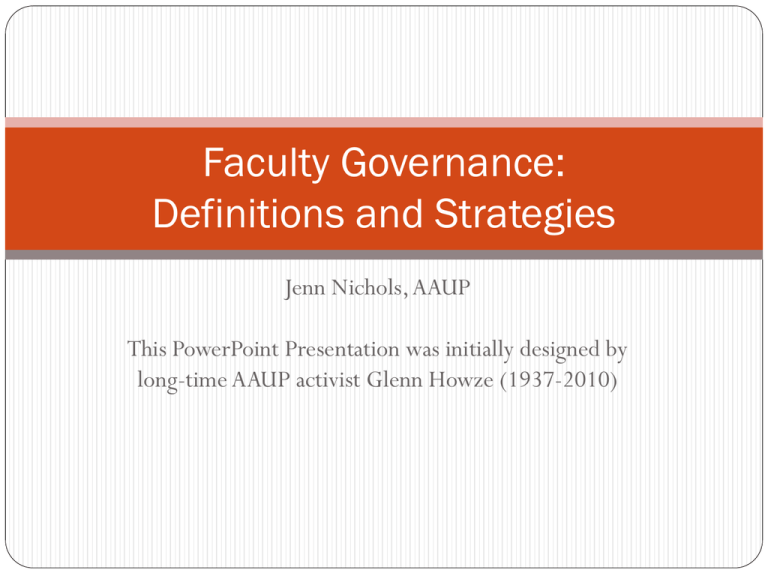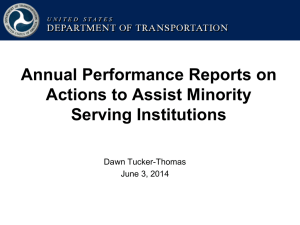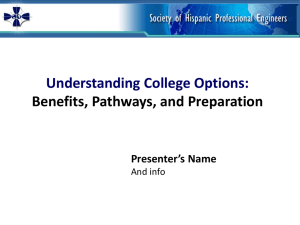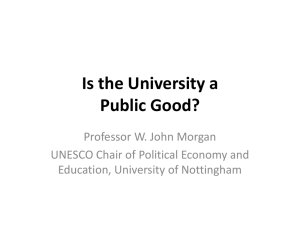Faculty Governance - Centenary College of Louisiana
advertisement

Faculty Governance: Definitions and Strategies Jenn Nichols, AAUP This PowerPoint Presentation was initially designed by long-time AAUP activist Glenn Howze (1937-2010) AAUP Position on Shared Governance Since its founding in 1915, the AAUP has advocated for significant faculty participation in university governance. The Association issued its first statement on governance in 1920, emphasizing the importance of faculty involvement in personnel decisions, selection of administrators, budget matters, and determination of educational policies. Refinements to the Association’s position were made in 1938 and 1958-64. 1915 Declaration of Principles These considerations [of the nature of the academic calling] make still more clear the nature of the relationship between the university trustees and the members of university faculties. The latter are the appointees, but not in any proper sense the employees, of the former. For, once appointed, the scholar has professional functions to perform in which the appointing authorities have neither competency nor moral right to intervene. The responsibility of the university teacher is primarily to the public itself, and to the judgment of his [sic] own profession… 1966 Statement of Government of Colleges and Universities Recommends “Shared” or “Joint” Governance, because… “The variety and complexity of the tasks performed by institutions of higher education produce an inescapable interdependence among governing boards, administration, faculty, students and others. The relationship calls for adequate communication among these components and full opportunity for appropriate joint planning and effort.” 1966 Statement of Government of Colleges and Universities Joint effort means everybody gets to participate depending on degree of responsibility: “…differences in the weight of each voice, from one point to the next, should be determined by reference to the responsibility of each component for the particular matter at hand…” 1966 Statement of Government of Colleges and Universities Who’s “Everybody”? Three “Components”: Governing Board Administration Faculty 1966 Statement of Government of Colleges and Universities Role of Students When students want to participate in campus governance, an attempt should be made to create meaningful involvement. Obstacles to participation are large --“inexperience, untested capacity, transitory status, “ and the fact that the board, administration and faculty are in positions of judgment over the students. 1966 Statement of Government of Colleges and Universities Role of the Governing Board Defines the overall role of the university. Possesses final decision-making authority (“owners”) Delegates the conduct of administration to administrative officers and the conduct of teaching and research to the faculty. Plays a major role in ensuring that the institution has the financial resources it needs to operate successfully. 1966 Statement of Government of Colleges and Universities Role of the President Is the chief planning officer Has the responsibility to make certain that the operation of the University conforms to the policies set by the governing board. Provides institutional leadership. Is the chief operational officer 1966 Statement of Government of Colleges and Universities Role of the Faculty: principles The faculty has responsibility (voice, authority) for matters in proportion to degree of expert knowledge. Therefore… Has “primary responsibility for…curriculum, subject matter and methods of instruction, research, faculty status, and those aspects of student life which relate to the educational process.” 1966 Statement of Government of Colleges and Universities Role of the Faculty: principles Because of expert knowledge, the faculty also… Has primary responsibility for faculty personnel decisions (“faculty status”): “appointments, reappointments, decisions not to reappoint, promotions, the granting of tenure, and dismissal.” 1966 Statement of Government of Colleges and Universities Role of the Faculty: principles For this same reason, the faculty… Has oversight over admissions. Sets requirements for degrees and determines when requirements have been met. 1966 Statement of Government of Colleges and Universities Role of the Faculty: recommendations (1) In areas of faculty primacy, boards and presidents should “concur with faculty judgment except in rare instances and for compelling reasons which should be stated in detail.” “Agencies for faculty participation in the government of the college or university should be established at each level where faculty responsibility is present.” 1966 Statement of Government of Colleges and Universities Role of the Faculty: recommendations (2) “An agency should exist for the presentation of the views of the whole faculty.” “Faculty representatives should be selected by the faculty according to procedures determined by the faculty.” 1966 Statement of Government of Colleges and Universities Role of the Faculty: communication Structures for communication among board, administration, and faculty should exist and “be clearly understood and observed.” These could include Circulation of memos and reports by board, administration and faculty committees Joint ad hoc committees Standing liaison committees. Membership of faculty on administrative bodies Membership of faculty on governing boards 1966 Statement of Government of Colleges and Universities Shared Governance is NOT The idea that a lot of conversation ought to take place within an among various campus groups—board, administration, faculty, staff, students, etc.—before the people in power make the final decision. i.e., the “stakeholder” version of shared governance. The “Stakeholder” Version of Shared Governance Premises of the “Stakeholder” Version When it comes to important issues, all final decision making power belongs to the board/administration. All subordinate campus constituents are pretty much equal, regardless of function and expertise (the insidious implication of the term “stakeholder”). 1966 Statement of Government of Colleges and Universities Essence of the Classic Conception All voices are NOT equal in institutional governance. The faculty exercises “primary responsibility” in areas of expert knowledge. Administration/board normally concur with faculty recommendations regarding areas of primary responsibility. 1966 Statement of Government of Colleges and Universities Essence of the Classical Conception, con’t. “…except for rare instances and for compelling reasons which should be stated in detail.” i.e., in academic matters, a faculty decision should normally be a final decision. Administration/board maintains a hands-off policy when it comes to curriculum, academic policy, and appointment, reappointment, tenure and promotion. Points to Remember Governance reform is a slow process. A governance document is never perfect. Shared governance will only work if faculty members are willing to devote the needed time and effort. Good communication is essential. Effective shared governance requires mutual trust and respect.








